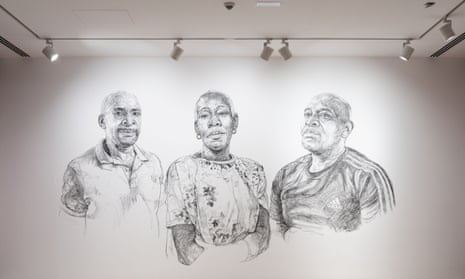An artist who reflects on the challenges of the Covid pandemic and another who explores the impact of the Windrush scandal are among four shortlisted for this year’s prestigious Turner prize, with the winner announced in December.
The work of Jesse Darling, Ghislaine Leung, Rory Pilgrim and Barbara Walker will be exhibited at the Towner Eastbourne from 28 September before the jury’s final choice.
Alex Farquharson, the director of Tate Britain and the chair of the Turner prize jury, said it was a “fantastic shortlist” for a prize that “offers the public a snapshot of British artistic talent today”.
He added: “These artists each explore the contrasts and contradictions of life, combining conceptual and political concerns with warmth, playfulness, sincerity and tenderness and often celebrating individual identity and community strength.”

Darling, an artist based in London and Berlin, uses sculptures and installations to “evoke the vulnerability of the human body and the precariousness of power structures”, the Tate said in its announcement.
The jury was struck by the artist’s ability to manipulate materials “in ways that skilfully express the messy reality of life” and expose “the world’s underlying fragility”.
Darling was nominated for solo exhibitions No Medals No Ribbons at Modern Art Oxford and Enclosures at Camden Art Centre.
Leung, a Swedish-born artist who lives and works in London, was particularly commended by the jury for the “warm, humorous and transcendental qualities that lay behind the sleek aesthetic and conceptual nature” of her work.

She was nominated for her solo exhibition Fountains at Simian, Copenhagen, in which a baby monitor, child safety gates, inflatable structures and toys were used to challenge the way art is produced and circulated. “We’re not used to [seeing] baby monitors. You think everything’s been done, not that art is a game, but it is about new approaches,” said Farquharson.
Pilgrim blends stories, poems, music and film created in collaboration with communities in the east London borough of Barking and Dagenham “to reflect on times of change and struggle during the pandemic”.
He was nominated for Rafts at the Serpentine and Barking town hall and a live performance of the work at the Cadogan Hall in London. The project was a “standout example of social practice”, according to the jury.
Walker’s work “interrogates past and present issues of racial identity, exclusion and power”. She was nominated for her presentation Burden of Proof at the Sharjah Biennial 15 in the UAE, which explores the impact of the Windrush scandal.
after newsletter promotion
The jury was impressed with Walker’s use of “portraits of monumental scale to tell stories of a similarly monumental nature, while maintaining a profound tenderness and intimacy”.
Farquharson said: “Part of her practice involves drawing directly on walls, and those drawings that literally take time, immense skill, [are] washed off at the end, in a practice that reflects … how people can be marginalised on account of their identity and injustice.”

The Turner prize, one of the best known prizes for visual arts, aims to promote public debate on new developments in contemporary British art. Last year it was won by Veronica Ryan, who created the UK’s first permanent artwork to honour the Windrush generation and at 66 was the oldest artist yet to be awarded the prize.
Each year, the winner receives £25,000 with the runners up getting £10,000 each.
Joe Hill, the director and chief executive of Towner Eastbourne, said the shortlist consisted of “an incredibly strong set of exhibiting artists, who ask us to look at some of the most pertinent issues of today, and who will collectively bring a sense of place and community to our galleries, through their diverse range of practices, from film and performance to drawing and sculpture.”
The members of this year’s jury are Martin Clark, director of Camden Art Centre; Cédric Fauq, chief curator of Capc musée d’art contemporain de Bordeaux; Melanie Keen, director of Wellcome Collection; and Helen Nisbet, artistic director of Art Night.
